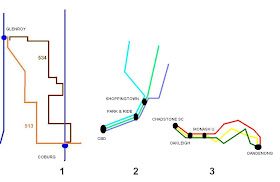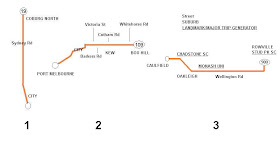Public transport in Melbourne's fringe is an interesting blend of urban and rural practice, as regards mode, operator, method of traction, service levels and absence or presence of route numbering. Historical factors regarding the choice of mode, and later decisions regarding service improvement, largely determine the type of and level of service offered.
The following lists the types of services provided to fringe areas.
a. Suburban (electric) trains, currently operated by Connex.
b. Inter-urban (diesel) trains, operated by V/Line (Stony Point excepted).
c. Regional coaches (has a country destination and no suburban route number)
d. Suburban buses (MOTC minimum standard)
e. Suburban buses (limited days/hours)
f. Suburban buses (occasional service)
The above is a classification based on a mix of mode, traction method and service level. However if service level only is considered, they can be placed into two groups; 'high service' or 'low service'. High service routes run 7 days a week from morning to at least mid-evening (9pm). Service frequency is 60-90 minutes or better. 'Low service' routes run only 5 or 6 days per week and/or have restricted spans and service frequency.
The areas themselves are equally diverse. They can be established seperate cities in the line of Melbourne suburban encroachment, a string of settlements on a scenic highway towards the hills or coast or a subdivision that was empty fields until a few years ago. I have classified these as follows, noting that some areas fall under more than one group:
A. Regional cities. Self-contained centres established in the 1800s with their own suburbs, local government and local bus networks. Do not always regard themselves as being part of metroplitan Melbourne, although some of their residents commute to metropolitan area jobs. Most housing is at suburban-type densities. Examples: Sunbury, Rosebud, Mornington, Healesville.
B. Regional hamlets and villages. Long established settlements smaller than the above but with a distinctive rural or coastal flavour. Vary in size but comprise at least a general store, a primary school surrounded by a few streets of housing at suburban densities. Examples: Cockatoo, Emerald.
C. New outer suburb. Melbourne frontier areas that have been subdivided into suburban-sized lots for new housing. May be stand-alone development with no established centre (eg Doreen or Point Cook) or be an accretion to an existing long-established centre (eg Werribee, Mornington, Berwick or Hastings).
D. Semi-rural. Residents live on acreages (eg hobby farms) and often commute for work in Melbourne or the nearest large regional centre.
E. Rural. Predomiantly agricultural land uses with low housing densities. Residents work locally, often on their land or in the nearest town.
The remainder of this item will group into discuss the transport available at a selection of fringe locations, grouped by service levels available. Capital letters after each name describe the area while small letters describe the transport type (note the area descriptions are rough approximations only).
Relatively high service areas
Doreen (Cd): Leap-frog sprawl has been upgraded from 'limited service' to 'minimum standards' service in last few months.
Gembrook (Bd): Local route (695) has been upgraded to minimum standards.
Hastings (ACbd): Hastings has had its train removed and then reinstated. It is also served by buses that roughly follow the line and are more frequent (but slower) than the train.
Healesville (Ad): Like Mornington Healesville lost its train and has suburban-numbered buses provided as substitutes.
Hurstbridge (Ba): This is the least urbanised fringe area to retain a suburban train service. A suburban span at half standard frequency applies. Despite its distance from the CBD it remained in the 'middle suburban' Zone 2 when the three-zone fare system was in force.
Lara (Bbe): Effectively an outer suburb of Geelong, Lara is served by an extension of that city's bus system as well as regional trains.
Melton (ACbe): Served by regional trains and local buses.
Mornington (ACd): Previously served by infrequent trains, Mornington has had these replaced by buses in 1981. Frequency and span upgrades to these services give central Mornington the most frequent service (20 minutes) of any fringe area in Melbourne.
Pakenham (ACad): The longest Melbourne suburban line (although electrification prevously extended to Traralgon). Served by (approximately) every second daytime Dandenong line train and has recently had a boost to evening train services and local bus services.
Portsea (Bd): Has long had a seven-day service but service span and frequency has been improved since Route 788 was upgraded to 'minimum standards'. Parts remote from 788 receive a limited service from Route 787.
Rosebud (Ad): Has long had a seven-day service but service span and frequency has been improved since Route 788 was upgraded to 'minimum standards'. Parts remote from 788 receive a limited service from Route 787.
Sunbury (ACbd): Served by regional trains and local buses. Electrification plans announced but not all locals are happy.
Warburton (Bd): This area was previously rail-served but has had the service replaced by coach-style buses displaying a suburban route number (683).
Warrandyte (Bd): Served by a variety of metropolitan bus routes, some to 'minimum standards'.
Whittlesea (BCd): Served by minimum standards route.
Yan Yean (Dd): A semi-rural area passed over by the urban frontier, which is now further north at Doreen. Upgraded to 'minimum standards' service in last few months.
Yarra Junction (Bd): This area was previously rail-served but has had the service replaced by coach-style buses displaying a suburban route number (683).
Yarrambat (BDd): Semi-rural area passed over by the urban frontier, which is now further north at Doreen. Served by two 'minimum standards' routes.
Relatively low service areas
Belgrave Heights (De): Route 697 limited service.
Clyde (Bcf): Receives service from a mix of suburban and regional routes.
Flinders (BF): Occasional service.
Humevale (BDe): Occasional service.
Kinglake (BDf): Once-daily service.
Koo-Wee-Rup (Bc): Served by country coaches only. However these have recently been upgraded and offer services that connect to a wide range of destinations during the day.
Manor Lakes (Ce): An outer part of Wyndham Vale. Fast-growing new housing area. Suburban housing densities.
Melbourne Airport (e): Limited service on regular services.
Pearcedale (BDf): A small settlement between Frankston and Cranbourne. Low density of housing.
Point Cook (Ce): A large area of new suburbia. Served by metropolitan buses (413, 416) operating at suburban-type frequencies but with limited days/hours.
Red Hill (BD): No service.
St Andrews (BD): No service.
Tarneit (Ce): A large area of new suburbia. Served by metropolitan buses operating at suburban-type frequencies but with limited days/hours.
Warneet (Bf): A small coastal settlement. Limited services (route 795) operate from Cranbourne.
Werribee South (BEe): A small coastal settlement remote from Werribee proper. Bus route (439) also served market garden area.
Wonga Park (De): Semi-rural acreages. Limited service.
Yarra Glen (BDf): Occasional service.
Conclusions
What are some patterns in the above list?
The first is that some relatively rural areas more than 50 km from Melbourne have quite high levels of service. Often these are ex-rail areas like Healesville, Yarra Junction and Mornington where the substitute coach provided runs more frequently than the train ever did. The 2006 regional rail timetable upgrades and the Meeting Our Transport Challenges 'minimum standards' program (for metropolitan buses) both boosted spans and frequencies in many of the better served areas listed above.
While I have not done any interstate comparisons, Melbourne appears to compare well with other cities like Perth that have very little urban fringe transport (Pinjarra, Serpentine, the Swan Valley and Mundaring for instance have limited or no service, and the twice-daily 'Australind' to Bunbury compares poorly with any of our RFR lines).
Some of the low service areas aren't very populated, so are unlikely to be a high priority for service improvements. However some might merit occasional services of the type provided under the 'Transport Connections Program' to rural areas.
Then there are the low service areas that already have high (and fast-growing) populations at suburban densities. Suburbs like Point Cook, Tarneit and Manor Lakes made it into the low service list as they are awaiting minimum standards upgrades, having been passed over in favour of other areas in the initial rounds. All of the latter (plus other low-service areas, eg around St Albans, Endeavour Hills, Frankston, Narre Warren and even Kensington Banks) are currently the subject of bus service reviews and may see improvement if likely review recommendations are implemented.




















